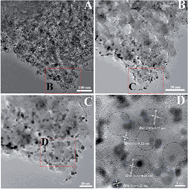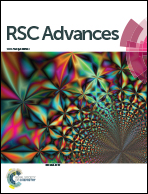Pt loaded onto silicon carbide/porous carbon hybrids as an electrocatalyst in the methanol oxidation reaction†
Abstract
Silicon carbide/porous carbon (SiC–PC) hybrids were directly synthesized via a facile evaporation-induced assembly approach combined with in situ carbothermal reduction in which soluble formaldehyde resin, a poly(ethylene oxide)-poly(propylene oxide)-poly(ethylene oxide) triblock copolymer and tetraethoxysilane were used as the source of carbon, the porogent and the source of silicon, respectively. The synthetic SiC–PC hybrid had a large specific surface area of 1163 m2 g−1 and the 10 nm SiC nanoparticles were well dispersed on the PC material. After loading with Pt nanoparticles, the resulting Pt/Si–PC catalyst had the highest reported unit mass electroactivity (836.93 A g−1 Pt) towards methanol electrooxidation (3.05 and 3.61 times the electroactivity of commercial PtRu/C and Pt/C catalysts). The Pt/SiC–PC catalyst also had a better stability than commercial PtRu/C and Pt/C catalysts. This enhanced electrocatalytic activity is attributed not only to the mutual effect of the hybrid support and the metal nanoparticles, but also to the large surface area that allows Pt to be used efficiently and gives the mass transportation required in a porous electrode. These results indicate that SiC–PC hybrids have great potential as high-performance catalyst supports for fuel cell electrocatalysts.


 Please wait while we load your content...
Please wait while we load your content...